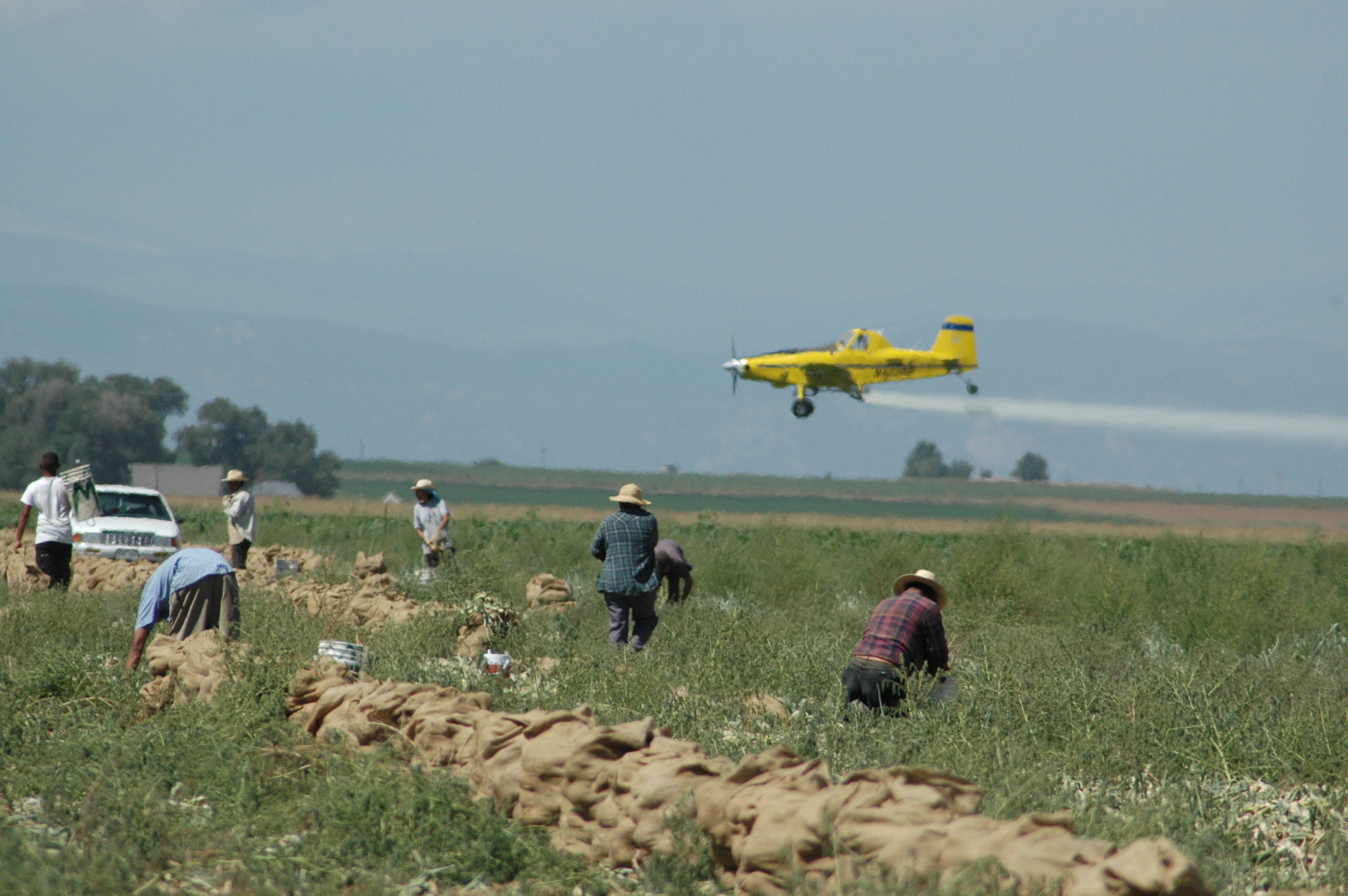More Than 175,000 People Call for Stronger Workplace Protections for Farmworkers

Farmworkers, public health advocates, labor organizations, and public officials, were among the more than 175,000 who submitted comments to the United States Environmental Protection Agency (EPA) calling on the agency to strengthen its Agricultural Worker Protection Standard (WPS). The WPS is the only federal standard designed to protect the nation’s more than 2 million farmworkers from one of their greatest occupational hazards: pesticide exposure.
“Farmworkers face dangerous exposure to poisons over the course of their working life,” said Eve Gartner, attorney for Earthjustice, a public interest law firm. “While most Americans benefit from broad workplace protections, farmworkers are not protected by the same health and safety standards.”
“The nation’s 2 million farmworkers deserve the level of workplace protections provided to other workers,” said Margaret Reeves, PhD, a senior scientist with Pesticide Action Network. “Protections for workers from pesticide exposure also mean protections for farmworker children and families.”
“Each year pesticide exposure poisons tens of thousands of farmworkers and their families,” said Virginia Ruiz, Director of Occupational and Environmental Health at Farmworker Justice. “We hope EPA responds to the hundreds of thousands of individuals who submitted comments in support of stronger protections and acts quickly to implement a Worker Protection Standard that prevents needless illness, injury, and death in farmworker communities.”
The groups are calling on EPA to change the proposed standard to include:
● Parity with safety rules provided to workers in non-agricultural industries
● Improved safety training annually and starting before workers enter treated fields
● Easily accessible information about pesticides used on the farm and in nurseries
● No children under 18 years of age allowed to handle hazardous pesticides
● Strict adherence to no-entry rules for areas recently treated with pesticides
● Improved protections and safety monitoring for pesticide handlers
Elvia Vasquez of Oxnard, California worked in the fields of Southern California picking strawberries, lettuce and broccoli for nearly a decade. "I would get rashes and headaches when forced to enter the strawberry fields that had been sprayed with pesticides only hours before," said Vasquez, who now works with Organizacion en California de Lideres Campesinas, Inc. to educate farmworkers on the dangers of pesticide exposure.
“We know the EPA has all the information they need to finalize a stronger, better WPS that actually provides real protections for the people who feed our nation,” said Tirso Moreno, General Coordinator of the Farmworker Association of Florida . “The administration has heard the stories from farmworkers and they know what is needed to do the right thing.”
"Millions of farmworkers are exposed to cancer-causing chemicals without adequate safeguards to protect their health," said Murshed Zaheed, Deputy Political Director at CREDO. "The least the EPA can do is take basic steps to protect farmworkers from being exposed to these toxic chemicals."
Indeed the administration has been hearing from workers and advocates for over a decade now – the WPS was first adopted in 1995 and has been awaiting revision since 2000. EPA is finally expected to issue the finalized rule by early 2015, after closing its public comment period on their proposal for a revised WPS at midnight on Monday, Aug 18.
More than 175,000 petition signatures were collected by Earthjustice, Farmworker Association of Florida, Farmworker Justice, Migrant Clinicians Network, Pesticide Action Network North America, United Farm Workers, and CREDO.
Farmworkers, public health advocates, labor organizations, and public officials, were among the more than 175,000 who submitted comments to the United States Environmental Protection Agency (EPA) calling on the agency to strengthen its Agricultural Worker Protection Standard (WPS). The WPS is the only federal standard designed to protect the nation’s more than 2 million farmworkers from one of their greatest occupational hazards: pesticide exposure.
“Farmworkers face dangerous exposure to poisons over the course of their working life,” said Eve Gartner, attorney for Earthjustice, a public interest law firm. “While most Americans benefit from broad workplace protections, farmworkers are not protected by the same health and safety standards.”
“The nation’s 2 million farmworkers deserve the level of workplace protections provided to other workers,” said Margaret Reeves, PhD, a senior scientist with Pesticide Action Network. “Protections for workers from pesticide exposure also mean protections for farmworker children and families.”
“Each year pesticide exposure poisons tens of thousands of farmworkers and their families,” said Virginia Ruiz, Director of Occupational and Environmental Health at Farmworker Justice. “We hope EPA responds to the hundreds of thousands of individuals who submitted comments in support of stronger protections and acts quickly to implement a Worker Protection Standard that prevents needless illness, injury, and death in farmworker communities.”
The groups are calling on EPA to change the proposed standard to include:
● Parity with safety rules provided to workers in non-agricultural industries
● Improved safety training annually and starting before workers enter treated fields
● Easily accessible information about pesticides used on the farm and in nurseries
● No children under 18 years of age allowed to handle hazardous pesticides
● Strict adherence to no-entry rules for areas recently treated with pesticides
● Improved protections and safety monitoring for pesticide handlers
Elvia Vasquez of Oxnard, California worked in the fields of Southern California picking strawberries, lettuce and broccoli for nearly a decade. "I would get rashes and headaches when forced to enter the strawberry fields that had been sprayed with pesticides only hours before," said Vasquez, who now works with Organizacion en California de Lideres Campesinas, Inc. to educate farmworkers on the dangers of pesticide exposure.
“We know the EPA has all the information they need to finalize a stronger, better WPS that actually provides real protections for the people who feed our nation,” said Tirso Moreno, General Coordinator of the Farmworker Association of Florida . “The administration has heard the stories from farmworkers and they know what is needed to do the right thing.”
"Millions of farmworkers are exposed to cancer-causing chemicals without adequate safeguards to protect their health," said Murshed Zaheed, Deputy Political Director at CREDO. "The least the EPA can do is take basic steps to protect farmworkers from being exposed to these toxic chemicals."
Indeed the administration has been hearing from workers and advocates for over a decade now – the WPS was first adopted in 1995 and has been awaiting revision since 2000. EPA is finally expected to issue the finalized rule by early 2015, after closing its public comment period on their proposal for a revised WPS at midnight on Monday, Aug 18.
More than 175,000 petition signatures were collected by Earthjustice, Farmworker Association of Florida, Farmworker Justice, Migrant Clinicians Network, Pesticide Action Network North America, United Farm Workers, and CREDO.
Categories
- Letters to the Editor and OpEds19
- Farmworker Justice Earned Media Reports0
- Farmworker Justice4
- 2024 Press Releases5
- 2023 Press Releases1
- 2022 Press Releases9
- 2021 Press Releases31
- 2020 Press Releases26
- 2019 Press Releases19
- 2018 Press Releases11
- 2017 Press Releases25
- 2016 Press Releases7
- 2015 Press Releases10
- 2014 Press Releases21
- 2013 Press Releases25
- 2012 Press Releases0

